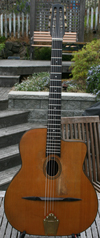A guitar of this stature needs no introduction. Next to Selmers,
Busatos are
the most sought
after guitars by today's top players. So many contemporary Gypsy jazz
guitarists play these exquisite guitars:
Romane (he plays a Busato on most of his recordings over the last 5
years)
Stochelo Rosenberg (performs with his Selmer but is an avid collector
and player of Busatos)
Yayo et Fanto Reinhardt (Romane's rhythm
section get an amazing dry rhythm sound with their Busatos!)
Moreno
and of course, Django himself! (see Django's Busato here:
Django's
Busato). Django is rumored to have written the ballad
Anouman
on his Busato.
This very Busato was owned by Neil Andersson, the lead guitarist for
Pearl Django. It was his main performing and recording guitar for many
years. It is considered by many to be one of the best sounding and
playing Busatos in existence.
So what makes a Busato so great? Generally speaking, it simply out
performs other guitars in almost every way. First off, they are
positively the loudest guitars every made! I've compared Busatos to
numerous classic Gypsy guitars such as Jacques Favinos and Selmers as
well as new guitars by J.P. Favino, Dupont, ALD, and Dell Arte. A good
Favino is pretty loud...but the Busato is just a cannon. A vintage
Selmer is actually quite timid by comparison.
The Busato has three tonal elements which really make it cut in
acoustic settings. 1) It is extremely dry. It has little or no natural
wetness (reverb.) This makes the guitar much more focused and is
therefore much easier to hear in a loud jam setting. 2) The tone is
very pure with very simple overtones. The fundamental pitch of single
notes are very strong while the overtones are extremely clean and even.
Very flute like in character. A Selmer sounds more complex, but is also
somewhat "messier" sounding which dampens projection. 3) It responds to
the slightest touch. Just barely strike the strings and you get a
lightening fast bolt of sound. I really like this because you don't
have to play these guitars hard to be loud.
Busatos yield an exceedingly wide frequency response. They have a
crisp, bright high end which gives your leads some sparkle and adds
ambiance and clarity to rhythm work. There's not much mids, except for
a slight upper midrange nasalness. But nothing like a Favino in that
regard. Like a Favino, there is far more low end then a Selmer, and
it's an incredibly tight, clear low end. Not mushy or ill defined in
anyway. The tight low end of a Busato mixed with it's dry character
really make it excel for rhythm playing. It's just so clear. The high
end cracks like a whip and the bass notes are like a kick in the gut.
The dimensions of Busatos are fairly close to that of Favinos. Same
long 675mm scale length. Body is 16 1/4" across the lower bout (Selmer
is 15 3/4", Favino is 16 1/2".)
Busatos are also the curviest Gypsy guitars out there. The bombé (top
arch) is the most pronounced I've ever seen on a Selmer type guitar.
It's like a huge bubble under the bridge. The back is also beautifully
arched.
This guitar has Brazilian Rosewood back and sides, a spruce
top, and a three piece mahogany neck with an ebony strip in the middle.
This guitar has the original BB tuners and tailpiece. The tuners have
brass buttons which are very classic looking.
It should be noted that there were many, many Busato models. Many of
which seem to be experiments. This model, which is often referred to as
the "Grand Modèle" (oval hole, 14 fret neck), is the one preferred by
the pros like Stochelo, Romane, Moreno, etc.
This guitar is currently strung with Argentine 11s and is incredibly
easy to play. Neil had extensive setup work done to this guitar by Josh
Hegg and John Saba. The setup is the best I've ever seen on a Selmer
type guitar. It plays like butter with no buzzes or other sonic
problems. It has a custom bridge made by Josh Hegg.
The neck is unusually slim for a Busato. It feels very modern and plays
easily. Most Busatos have a much thicker neck. So this one is special in that regard.
The condition of the guitar is excellent. It has some pick wear on the
top and various minor dings and scratches. No cracks can be seen.
This guitar actually has the original Busato label on the neck block.
It's the only Busato I've ever seen with a label! It's near impossible
to date Busatos...but my guess is this was built in the late 40s.
This is the CASH price...add 3% if you'd like to pay with a credit
card. 4% for International orders.
 Busato
The best of the best, Busato's guitars are legendary for their tone and projection!
Arts & Entertainment
busato-oval-hole-grand-modele-1
Grand Modele
View Offer
DjangoBooks.com
https://www.djangobooks.com/Item/busato-oval-hole-grand-modele-1
Busato
The best of the best, Busato's guitars are legendary for their tone and projection!
Arts & Entertainment
busato-oval-hole-grand-modele-1
Grand Modele
View Offer
DjangoBooks.com
https://www.djangobooks.com/Item/busato-oval-hole-grand-modele-1


















